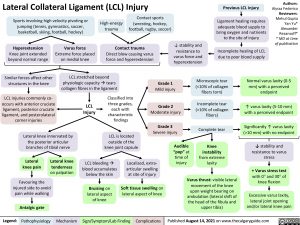Lateral Collateral Ligament (LCL) Injury
Previous LCL injury
Ligament healing requires
adequate blood supply to bring oxygen and nutrients to the site of injury
Incomplete healing of LCL due to poor blood supply
Authors: Alyssa Federico Reviewers: Mehul Gupta Yan Yu* Alexander Rezansoff* * MD at time of publication
Sports involving high velocity pivoting or jumping (tennis, gymnastics, soccer, basketball, skiing, football, hockey)
High-energy trauma
Contact sports (wresting, hockey, football, rugby, soccer)
Hyperextension
Knee joint extended beyond normal range
Similar forces affect other structures in the knee
LCL injuries commonly co- occurs with anterior cruciate ligament, posterior cruciate ligament, and posterolateral corner injuries
Lateral knee innervated by the posterior articular branches of tibial nerve
↓ stability and resistance to varus force and hyperextension
Varus force
Extreme force placed on medial knee
Contact trauma
Direct blow causing varus force and hyperextension
LCL stretched beyond physiologic capacityàtears collagen fibres in the ligament
Grade 1
Mild injury
Grade 2
Moderate injury
Grade 3
Severe injury
Microscopic tear (<10% of collagen fibers torn)
Incomplete tear (>10% of collagen fibers)
Complete tear
Knee instability from extreme laxity
Normal varus laxity (0-5 mm) with a perceived endpoint
↑ varus laxity (5-10 mm) with a perceived endpoint
Significantly ↑ varus laxity (>10 mm) with no endpoint
↓ stability and resistance to varus stress
+ Varus stress test
with 0° and 30° of knee flexion
Excessive varus laxity, lateral joint opening and/or lateral knee pain
LCL Injury
Classified into three grades, each with characteristic
findings
LCL is located outside of the knee joint capsule
Lateral knee pain
Lateral knee tenderness on palpation
LCL bleedingà blood accumulates below the skin
Bruising on lateral aspect of knee
Localized, extra- articular swelling at site of injury
Soft tissue swelling on lateral aspect of knee
Audible “pop” at time of injury
Favouring the injured side to avoid pain while walking
Antalgic gate
Varus thrust: visible lateral movement of the knee upon weight bearing on ambulation (lateral shift of the head of the fibula and upper tibia)
Legend:
Pathophysiology
Mechanism
Sign/Symptom/Lab Finding
Complications
Published August 14, 2021 on www.thecalgaryguide.com

